PARISH OF MAGHERADROLL
by Frank McCorry
The Parish of Magheradroll or Ballynahinch, located
in the east of the diocese in the heart of County Down, vies with the
Parish of Dromore as the most extensive parish in the Dromore Diocese.
Magheradroll includes the ancient parish of Annahilt. There are
thirty-six townlands in the parish. The parish name probably derives
from `Machair Eadar Ghabhal' - the plain between the rivers, viz. the
River Lagan and its tributary, the Ravernet River. First mentioned in
the Papal taxation of 1291 as `Ardagualla', the lands of Magheradroll
were once an integral part of Magennis territory, some of which was
shared with their kin, the MacCartans. The ancient cemetery of the
parish was in the townland of Magheradroll and it was there that a
church was erected in 1607 by the Catholics of the parish under the
patronage of the Magennises and MacCartans.
On account of its location close to Seaforde and
Loughinisland in Down and Connor, Magheradroll appears somewhat remote
to parishes lying to the west of the diocese. The northern part of the
parish which adjoins Hillsborough, once a great Magennis stronghold,
contains no Catholic church. This means that St. Patrick's, Church
Street, Ballynahinch, serves twenty-four northern and central townlands,
including the town of Ballynahinch. The southern section of the parish
is served by the Church of Christ the King, Drumaness and St. Colman's
Church, Dunmore. The pre-Reformation church at Crabtree Hill,
Ballynahinch, was taken over by incoming Anglicans at the time of the
Plantation. Tradition maintains that some Catholic people used the
church for Mass up until the mid-18th. century period.

ST. PATRICK'S, BALLYNAHINCH

St. Patrick's Church,
Ballynahinch, was completed in 1812. It was
rededicated in 1843. The striking stone tower and
the Church's transepts were built in the 1860s.
The imposing St. Patrick's Church, on its elevated
site in Ballynahinch, replaced a small Mass station in Dromore Street
which had served congregations for upwards of thirty years. Lord Moira,
a landed nobleman who supported Catholic Emancipation, gave the site of
St. Patrick's to the parish, its favoured location characterising the
generous disposition of the landlord. The original St. Patrick's was
probably begun c.1806-07, and used for Mass in 1808, twenty years before
Emancipation. The church was completed in 1812, aided by funds raised by
the preaching of a special charity sermon.
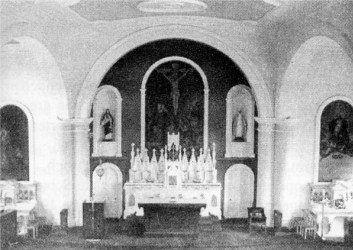
The interior of Ballynahinch Church
following the re-ordering which came with the Second Vatican
Council. Many parishioners will remember the sanctuary as it
was before the major renovations of the early 1990s.
During the `Night of the Big Wind,' 6th.-7th. January
1839, the church suffered major damage. The extent of the destruction
was such that the re-dedication ceremony was not undertaken by Bishop
Michael Blake until September 1843. In common with many other urban
Catholic Churches in Ireland, St. Patrick's was re-ordered during the
1860s and again in the 1890s. These were crucial decades when
Catholicism flourished once again, as the Church provided leadership,
strong moral guidance and internal discipline for growing congregations
throughout the land. The re-ordering of St. Patrick's in the 1860s -
involved the building of the transepts and the Church ' tower, In the
late-1890s, a gallery was erected and a High-Altar and side-altars
installed.
Additional renovations were carried out in the 1930s, a decade
remembered for a series of significant initiatives undertaken by Canon
Edward McGivern. These included the erection of the Church of Christ the
King, Drumaness, the opening of Drumaness Primary School, the founding
of Assumption Grammar School for Girls, the building of a new parochial
hall, and the laying out of a new cemetery. Historians are now taking a
fresh look at the 1930s, M regarded as a decade of increased poverty and
hardship, yet in Ballynahinch and other northern towns, a period of
decided progress, particularly in house-building and associated
projects.
During the 1980s and early 90s, St. Patrick's Church
and the entire church-related site were transformed. The church was
subject to a major scheme of renovation and extension. Alongside the
church, a very impressive parish centre was built, new car-parks were
laid out, and the cemetery updated. The Church was re-opened on June
6th. 1993, by Bishop Francis Gerard Brooks who stated that the newly
renovated church and adjoining buildings were "a symbol of the living
community of Christ's followers."

ST. COLMAN'S CHURCH, DUNMORE
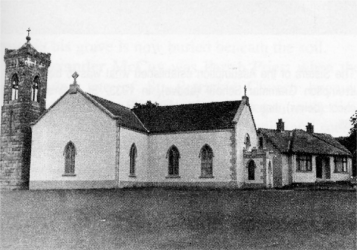
St. Colman's Church, Dunmore, which was
originally dedicated in 1840, was raised in height and
extensively renovated in 1955. It was rededicated, following
further enhancement, in December 1999. The adjoining
presbytery is now used as a youth club.
The construction of St. Colman's Church, Dunmore,
located in the hills, four miles south of Ballynahinch, was begun in
1831. The church was completed and dedicated in July 1840. Close by is
the site of a Penal Mass Station at Guiness. Also nearby is the site of
the ancient Church of Templemoyle in which Mass was celebrated prior to
the Reformation. In early days, lighting in St. Colman's was provided by
means of a windmill located adjacent to the old parochial house. Mass
paths led to the Church from different directions. Similar lane or path
networks can still be seen in medieval church sites at Derrynoose, in
south Armagh, and at Old Aghagallon, in south-west Antrim.
At one time, Dunmore was attached to the hilly parish
of Dromara. The tiny village of Dunmore stood near the ancient Church at
Templemoyle. The Church site is situated on a rise beside the Forde
river which bounds the site on three sides. A fraction of the original
walls remains visible, and local people speak of the small circular
cemetery which surrounded the church. Two thorn trees mark the spot
where the altar would have stood. This also can be seen at the
impressive crannog-like medieval church site at La-Loo, in south-west
Antrim. Templemoyle, overall, yields many of the features associated
with ancient church-sites throughout Ireland.
St. Colman's Church, which had remained more or less
in its original state, was almost completely rebuilt in 1955. The walls
were raised by almost six feet. A new apse and sanctuary were built. New
stained glass windows were installed. At the re-dedication of St.
Colman's, in 1956, the Reverend B.J. Mooney, C.C., Clonduff, (later Dean
Mooney, P.P. Seagoe), provided a significant historical background to
Dunmore. He stated that from time immemorial the townland of Dunmore had
been a centre of Catholic worship. This was going back to the days of
Templemoyle about which so little was known, not even its proper name.
Templemoyle - teampall maol - means the ruined church. Fr. Mooney added
that the original barn used in Dunmore for the celebration of Mass was
loaned to the congregation by a Mr. Ritchie, a local Protestant farmer,
whose name was rightly remembered and honoured by local people.
In 1998, another major project of restoration and
refurbishment was carried out on St. Colman's Church. This particular
project involved specialist re-rendering of the walls, complete
re-roofing of the church, the installation of new flooring, new
confessional areas, redecoration of the church, and updating of all
externals, viz. entrance porch, entrance gates and car-park. The
re-dedication ceremony on Sunday 12th. December 1999, was conducted by
Bishop John McAreavey who concelebrated with Archdeacon Liam Boyle,
Canon Joseph O'Hagan, Canon Gerard McCrory, Fr. Brian Brown, Fr. J.J.
Cunningham and Fr. Francis Lyons. Canon Aidan Hamill was Master of
Ceremonies.

CHURCH OF CHRIST THE KING,
DRUMANESS
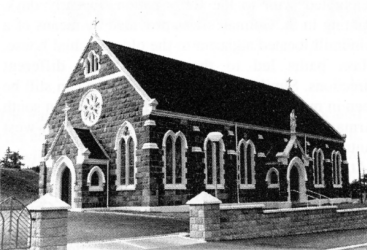
The Church of Christ the King is the youngest
of Magheradroll's churches. It opened in 1936 and has served,
for almost seventy years, the community which originally grew up
around Drumaness Mill.
The Church of Christ the King, Drumaness, was
dedicated on its feast day by Dr. Mulhern, Bishop of Dromore, on October
25th. 1936. The preacher was Very Reverend Arthur Ryan, D.D., Queen's
University, Belfast. The first Mass in the new Church had been
celebrated five months earlier on Sunday 28th. June. Four miles distant
from Ballynahinch and five miles distant from Dunmore, it is said that a
number of Mass-rocks existed in the Drumaness district. There had been a
small local Catholic school in the district, and when it fell into a
dilapidated state, Canon McGivern decided to erect a new church as well
as a new school. The generosity of parishioners towards the new
buildings is recorded in a publication of the year 2000, `A History of
the Parish of Magheradroll'. The new Church cost approximately �8,000
and the school, �4,000.
The village of Drumaness had evolved as the result of
the opening of a spinning mill, in 1850. As the linen industry
flourished, so the mill prospered, and Drumaness emerged as a red-brick
settlement like so many other villages and town sectors associated with
the linen and cotton trades in east Ulster. The mill closed in 1965.

The development and expansion of the parish had
implications for the size and enrolment of local schools. St. Patrick's
Primary School, Ballynahinch, evolved from National Schools which were
conducted as separate boys' and girls' schools from 1864 to 1958. In
1980-81, a major extension to St. Patrick's was accompanied by the
introduction of an array of modern facilities. Drumaness Primary School
emerged alongside the Church of Christ the King, in 1939, replacing a
two-classroom Public Elementary
School which had also been used for celebrating
Sunday Mass. In 1969-70, the school premises were considerably updated
with new classrooms, the installation of a modern heating system, and
new kitchen facilities. Guiness Primary School, founded in 1848, is a
small rural school, staffed for the greater part of its existence by two
teachers supported, in recent years, by ancillary staff.
St. Colman's High School, Ballynahinch, was
officially opened as a modern Intermediate School by Bishop Eugene
O'Doherty on September 6th. 1965. A major three-storey extension was
begun in 1989, and officially opened by Bishop Francis Gerard Brooks in
March 1991. The cost of the original school was �200,000, and the
extension, �1.6 million. A new science block was added in 1998.
Assumption Grammar School, Ballynahinch, is
recognised throughout the diocese and beyond as a leading girls' grammar
school. The Sisters of the
The Sisters of the Assumption established what was to become
the Assumption Grammar School (left), in 1933. St. Colman's High
School (right), has served Ballynahinch and a wide hinterland
since 1965.
Assumption became a newly formed religious
congregation in Paris during the 1880s. At the beginning of the 20th.
century, a daughter congregation was formed from a group of nuns who
were working among orphans and widows in troubled South Africa. By 1911,
this congregation was being led by Mother Baptist McKenny, a native of
Ballymacan, outside Ballynahinch. In 1932, Mother Baptist formed a
community in Ballynahinch, and soon had gathered a group of postulants,
some of whom went to work in South Africa. A local convent was
established in 1933, and a school opened with twenty boarders in
September that year. Under the name of Assumption High School, the
school progressed, and under the important Education Act of 1947, it
became known as Assumption Grammar School. In 1960, the enrolment was
250. In 1982 it had risen to 695. By 1994, 860 girls were on roll, and
in 2000, the enrolment had increased to 910. The importance of the
school to Catholic families throughout County Down is reflected in these
enrolment figures and also in the excellence achieved through the broad
and specialised curriculum available.

PARISH PRIESTS OF MAGHERADROLL
Fr. Francis McKenny was parish priest of
Dromara and Magheradroll in 1781-88. He resided in Ballymacarn North,
south-west of Ballynahinch, where he held a farm from Lord Moira. When
he died in 1788, he was interred in the cemetery adjoining the Church of
Ireland in Dromara, which was formerly in Catholic hands. His grave is
to the right of the cemetery entrance but the memorial which formerly
marked his grave is now buried beneath the soil.
Fr. Alexander McCoy was Parish Priest when the
present-day site of St. Patrick's Church became parochial property. The
Church was begun in the first decade of the 19th. century when financial
and socioreligious constraints were formidable. Father McCoy appears to
have been the first Parish Priest of Magheradroll as a separate parish.
Father James Moore was ordained in Newry by
Dr. Derry, in 1814, and became Parish Priest in 1821. He died five years
later in July 1826. His short pastorate was marked by a deep involvement
with the people of the parish. This is reflected in the inscription of
the memorial within the church porch which refers to Father Moore as the
`revered Parish Priest of Ballynahinch, Dunmore and Annahilt'. The
inclusion of Annahilt is indicative of the anomalies which arose in
parish and diocesan boundaries during the period, 1810-30, when the
Catholic Church was re-grouping and re-organising in the wake of centuries
of major constraints.
In the seven-year period, 1836-43, two parish priests
served Magheradroll Parish, viz. Fr. Peter Polin and Fr. Henry O'Hagan.
The former was a native of Dromara Parish, and the latter emanated from
the Parish of Clonduff. Fr. O'Hagan's pastorate in Magheradroll lasted
only eighteen months. He died on September 19th. 1833, aged around
thirty years, and was interred in Leitrim cemetery. He was renowned for
his great learning.
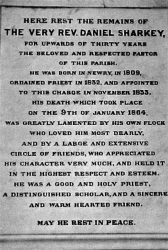
Fr. Daniel Sharkey, who served the parish
for thirty-one years, is fondly remembered by this stone
located in the side-entrance porch of Ballynahinch Church.
Reverend Daniel Sharkey was appointed to
Magheradroll in November 1833, at the age of twenty-four years, just one
year after his ordination. In the same year, his brother, Fr. John
Sharkey was ordained, and later became Parish Priest of Dromore. During
Fr. Daniel Sharkey's pastorate, important structural initiatives were
undertaken within the parish, including the rebuilding of Ballynahinch
Church which had been severely damaged in the 'Night of the Big Wind.'
Fr. Sharkey died on January 6th. 1864, aged 54 years. His brother had
passed away five years earlier, also a relatively young man.

Reverend Charles O'Hare was appointed Parish
Priest immediately after Fr. Sharkey's death, having served for one year
as curate. He had also served as President of St. Colman's College,
Newry, for one year, 1850-51. During Fr. O'Hare's stay in the parish,
the transepts and tower were added to St. Patrick's Church, and the
improvements were so major that the edifice was described as 'a new
Church.' Fr. O'Hare died in January 1887, and was interred within
Ballynahinch Church.
Reverened John McGrath came to Magheradroll in
February 1887. As a young student, he had been in charge of St. Colman's
College from September 1851 until April 1853. During the period, there
were few students at the college. Fr. McGrath was ordained in 1860 by
Dr. Leahy, and served as curate in Newry, Annaclone, Upper Drumgooland,
and Rostrevor (1865-67). While in Rostrevor, he was also serving as
President of St. Colman's College, where he taught for two and a half
years. Students who attended the college when Fr. McGrath was President
paid tribute in later life to his scholarship and to his ability as a
teacher. He died in January 1897, and was interred within St. Patrick's
Church.
Reverend John Doyle, a native of Lower
Drumgooland, educated in the Irish College, Salamanca, ordained in
Newry, June 1874, was appointed Parish Priest of Magheradroll, in
February 1897. He remained in Ballynahinch until his death in January
1931. He was Archdeacon of the diocese from July 1923, and supervised
the erection of the new high-altar and side-altars in 1897.
Father Edward McGivern, who had been a very
valued curate in L�rgan, 1920-24, became Parish Priest in January 1931,
and served until his death in December 1938. During his term, he
renovated Ballynahinch Church, improved St. Colman's, Dunmore, and
organised the building of the Church of Christ the King, Drumaness.
Canon Michael McCrory, a native of Annaclone
and educated at the Irish College in Rome, was ordained in Rome in May
1899. He was appointed Parish Priest in December 1938, and served until
1967, when due to ill health, he resigned his parish. He continued to
reside in the parish priest's house in Ballynahinch until a few weeks
before his death. He passed away in the Alexian Brothers' Home,
Warrenpoint, on December 16th. 1969, when aged 93 years. He had assisted
at the blessing and formal opening of the new St. Colman's Secondary
Intermediate School, Ballynahinch, in September 1965, one of two new
schools erected during his term as Parish Priest.
Canon Alexander McMullan was appointed Parish
Priest of Magheradroll on October 18th. 1967. He was a native of
Legananny, in the Parish of Leitrim, and emanated from a family renowned
for their enormous contribution to the Church in the Dromore Diocese and
the Missions, throughout the 20th. century. Before coming to
Ballynahinch, Canon McMullan was C.C. Warrenpoint for twenty-three
years, and P.P. Dromara for nine years. He died suddenly on Monday 7th.
August 1975. The year, 1975, was also marked by the deaths of Canon
Thomas Pettit, in St. John of God, Newry, Monsignor Michael Carvill, in
Los Angeles,
Father Seamus Moore, in Newry, and of Dean
Bernard Mooney, in Warrenpoint. In the same year, Dr. Eugene O'Doherty
retired as Bishop of Dromore, and an announcement was made that his
successor would be Canon Francis Gerard Brooks, President of St.
Colman's College, Newry.
Canon Patrick Smyth was appointed Parish
Priest in Ballynahinch, in September 1975. He had been C.C. in Shankill
Parish, Lurgan, for twenty-seven years, in the period 1948-75, where his
dedication to the parish and parishioners is still recalled. In
Ballynahinch, Canon Smyth undertook major projects of extension,
renovation and innovation. These included the radical adjustment of the
interior of St. Patrick's Church with the inclusion of an array of new
features, the erection of a new parish centre, and complementary works
in the tiered car-park and cemetery. At the re-opening and dedication of
the Church in June 1993, Canon Smyth paid special tribute to Fr. Aidan
Hamill, his curate, for the tireless efforts in realising the completion
of the huge task of major construction. Upon retirement in August 1993,
Canon Patrick Smyth became C.C. Ballela. He passed away on June 26th.
1998, and was interred in Mayobridge four days later. At his funeral
Mass, Canon Joseph O'Hagan, then in his 87th. year, preached a memorable
and moving panegyric, without notes of any kind, in wonderful tribute
to his "lifelong friend."
Father Gerard McCrory, from that part of
Shankill Parish, Lurgan. which borders on Lough Neagh, was appointed
Parish Priest of Magheradroll in 1993, succeeding Canon Smyth. Fr.
McCrory was ordained on June 1 1 th. 1966, and appointed C.C. Donaghmore
and in the following year, C.C. Rathfriland. In 1972, his duties were
increased by his appointment as Instructor in Religion in Secondary
Schools. From 1974 onwards, Fr. McCrory's responsibilities were centred
in St. Colman's College, Newry, first as Bursar, then as Spiritual
Director and, afterwards as Vice-President. During these years Fr.
McCrory played a very important part in furthering vocations to the
priesthood, a role to which he brought great commitment. In June 1998,
he was appointed a Canon within the Diocesan Chapter.

Fr. Aidan Hamill's support for Canon Patrick Smyth's
ministry in Magheradroll exemplifies the role of parish curates. Fr.
Brian Brown has contributed similarly to the pastorate of Canon Gerard
McCrory. Until recently, the work was shared by Fr. J.J. Cunningham. Fr.
John F. McCauley (1940-58) and Fr. Liam Boyle (1958-80) contributed
considerable longterm support to parishioners during their stay in
Ballinahinch. In the 1930s, there was a Fr. J. Lennon, working in
Ballynahinch and another Fr. J. Lennon based in Dunmore. Fr. Joe O'
Hagan, Fr. Jim Mooney, Fr. Tom McConville and Fr. Conal O'Donnell were
curates in Dunmore in the 1950s and 1960s. In more recent times, Fr.
Brendan McAteer, Fr. James O'Hanlon, Fr. Frank Lyons and Fr. Patrick
Kelly were based in Dunmore.
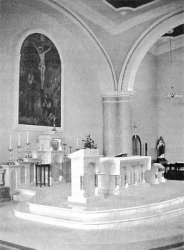
The sanctuary of St. Patrick's,
Ballynahinch, (left), as it is today. It was transformed
by major renovations and re-dedicated in June 1993.
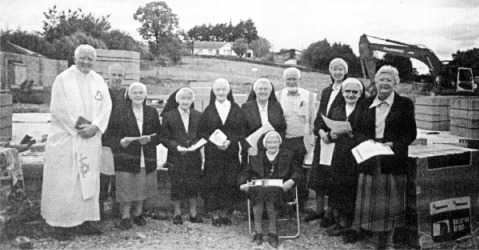
Missionary Sisters of the Assumption have
resided in Ballynahinch since 1932. Their convent building is to
be incorporated into the campus of the expanding Assumption
Grammar School. As a result, the Sisters built a new home in
2003-04. This photograph, (below), was taken in August 2003, on
the occasion of the blessing of the site for the new convent.
Members of the community are pictured with Sr. Loreto O'Reilly
(Superior), Canon Gerry McCrory P.P., who performed the ceremony
and representatives of the building contractors, Messrs. Savage
and Napier. The new convent was opened by Bishop John McAreavey
on 1st. June 2004.
 |